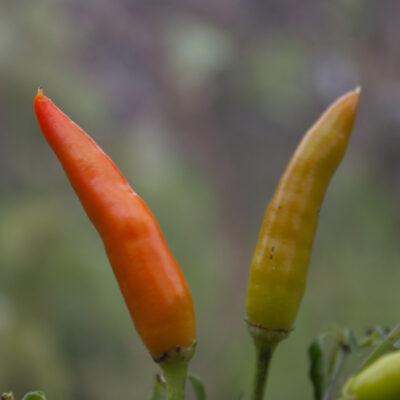When it comes to gardening, climate change means a revision of expectations and ideas. These days, an unheated greenhouse provides useful protection for tender crops for longer than ever before. When October frosts were the norm, you wouldn’t even consider leaving chillies to ripen in the greenhouse but now it is more commonplace. Keep checking the weather forecast and when much colder weather is predicted, bring them indoors to ripen in a fruit bowl, paper bag with a ripe banana or in a sunny spot on a windowsill.
Continue to sow batches of winter salads weekly in an unheated greenhouse. With it is warm and sunny, sow trays, pots, old growing bags or borders with ‘cut and come again crops’ to harvest through autumn and into winter. Try land cress, pak choi, mizuna and mibuna greens plus lettuce, lamb’s lettuce, chicory and radish. You can also use what’s left in the packets from earlier brassica sowings and harvest them earlier as microgreens.

Cuttings of tender plants taken in September and annual seedlings sown earlier in the year, can now be transplanted into pots one or two sizes larger. Just check that there are plenty of roots showing on the outside of the root ball before repotting and if there are none showing, delay repotting.
Finish tidying the green house, remove any emerging weed seedlings from borders and gravelled benches. Brush out then wash pots and seed trays in a solution of environmentally friendly disinfectant, rinse them thoroughly, allow to dry, then stack them safely. It is worth sorting through your collection of pots and trays to check you have sufficient numbers of all sizes and buy more if necessary. Ensure you have enough labels and a marker pen or pencil, so you are fully prepared for seed sowing next spring.
With rising energy prices, I don’t heat the whole green-house anymore. Plants that are overwintered in dry compost like cannas are covered with up to three layers of horticultural fleece as frost protection with larger, more tender (and more expensive!) plants like the Purple Leaved Banana ‘Ensete ventricosa’ receiving greater protection. Smaller plants can be moved into the plant propagator with heating cables keeping them frost free.
Keep a look out for overwintering whitefly, mealy bug or red spider mite on greenhouse plants and treat them with environmentally friendly sprays.
I once visited a large greenhouse where the owner had installed four black metal drums filled with water. On sunny days, (which are often followed by cold nights) they absorbed the heat from the sunshine then radiated it out at night, keeping temperatures in the greenhouse slightly higher – a bit like the old night storage heaters. The increase in temperature isn’t huge but it was just enough to keep the greenhouse frost free. At when spring arrived, the water was drained off and used to fill water butts. It is an interesting idea that I am trying with plastic watering cans, though metal ones would are even better. The lowest temperature tolerated by most plants is between 7-10C (45-50ºF). Have a peaceful and happy Christmas. Matt










